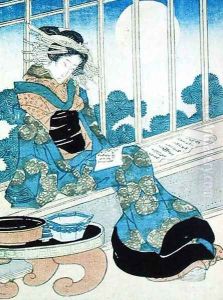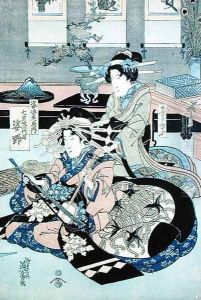Keisai Yeisen Paintings
Keisai Eisen was a Japanese ukiyo-e artist who lived during the late Edo period of Japan. Born in 1789 in Edo (present-day Tokyo), Eisen was not only a prolific painter and printmaker but also a writer, particularly known for his landscapes, beauties (bijin-ga), and kabuki actor prints. He is often confused with or thought to be closely associated with another prominent ukiyo-e artist, Kikugawa Eizan, due to the similarities in their styles and subjects. Eisen's works are characterized by their vibrant colors, intricate details, and the delicate portrayal of figures, which contributed to the flourishing of the ukiyo-e genre during his time.
Eisen's early life was marked by hardship. He was born into the Ikeda family, and after the death of his father, who was a notable calligrapher, he was adopted into the Keisai family. Despite these early challenges, Eisen pursued his interests in art, studying under several masters including Hakuyō Daiō and later under Kikugawa Eizan. His early works were kabuki actor prints, but he gradually shifted his focus to the genre of bijin-ga, or pictures of beautiful women, which earned him considerable fame. Eisen's depictions of the pleasure quarters, particularly those of Yoshiwara, are among his most celebrated works, offering a glimpse into the courtesan culture of Edo-period Japan.
In addition to his artistic career, Eisen was an accomplished writer. He published several books, including a well-known guide to Tokyo's Yoshiwara pleasure district. His literary works provide valuable insights into the cultural and social aspects of the Edo period, complementing his artistic endeavors.
Despite his success, Eisen's life was not without controversy. He reportedly led a tumultuous life, marked by financial difficulties and rumors of involvement in the darker aspects of the pleasure quarters he often depicted. Nonetheless, his artistic legacy is significant, with his prints being highly regarded for their historical and cultural value. Eisen's contribution to the ukiyo-e genre has been recognized in various exhibitions and collections worldwide, ensuring his place among the great masters of Japanese art. He passed away in 1848, leaving behind a body of work that continues to captivate and inspire.

